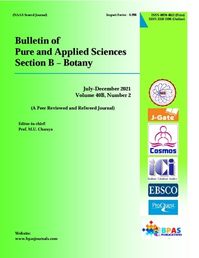Soil-Vegetation Relations in Some Stations of the Kabylia Region (North Algeria)
DOI:
https://doi.org/10.48165/Keywords:
Inventory, Flora, Soil, Ecological analysis, kabylieAbstract
In order to characterize the soil-vegetation relationship in Kabylia, a qualitative inventory of plant species was carried out in the stations of Sidi Ali Bounab, Redjaouna and Mizrana (Tizi-Ouzou) during the spring season 2022 as well as physico-chemical analyzes of the soil (texture, total limestone CaCO3, pH, electrical conductivity as well as organic matter). The inventory of the flora collected made it possible to draw up a systematic list of 54 species, of which 26 species are listed at the level of the Redjaouna station, which is the more diversified, 23 species at the station of Sidi Ali Bounab and only 15 species at the station of Mizrana. The latter belong to 25 botanical families, 22 orders, 4 classes (Liliopsida, Equidopsida, Magnoliopsida and Flicopsida), and 5 divisions of the kingdom Planteae. The Fabaceae family dominates in the Redjaouna and Sidi Ali Bounab stations, so much said that at the Mizrana station it is the Asteraceae family that dominates. The analysis of the quality of the soils by determining their physical and chemical properties reveals that it is favorable to the installation and the diversification of the flora thanks to their loamy-sandy texture rich in organic matter and their neutral pH as well as their electrical conductivity, which is confirmed by the ecological analysis (equitability which tends towards 1) as well as statistical analysis by ACP and CAH.
Downloads
References
Chapin F., Matson P., Vitrousek P. (2011). Principles of terrestrial ecosystem ecology. Edspringer, N° 2, New-York.
Dahmani M. (1996). Diversité biologique et phytogéographique des chênaies vertes d'Algérie. Ecologia Mediterannea XXII. (3/4). pp 19-38.
Freshet G.T., Violle C., Roumet C. et Garnier, E. (2018). Interaction entre le sol et lavégétation: structure des communautés de plantes et fonctionnement du sol. Les sols au cœur delazonecritique:écologie (eds P.Lemanceau et M. Blouin), ISTEédition,
pp.83-99.
Grandner C.M., Laryea K.B. et Unger, P.W. (1999). ‘Soilphysicalconstraints to plant growth and cropproduction’. (eds. Land and Water Development Division, Food and Agriculture Organization.
Jodra S. (2015) «les rosacées». Imago Mundi. 44.
Lembrouk L. and Sadoudi-Ali Ahmed D. (2022). Flora Diversity According to an Altitudinal Gradient in Kabylia Region, Bulletin of Pure and Applied Sciences Section B-Botany (Plant Sciences), 41B(1), 53-
Loisel R. (1978). Phytosociologie et phytogéographie; signification phytogéographique du Sud–Est méditerranéen continental Français. Docum. phytosociologiques, N.S. Vol II. Lille. pp 302-314.
Ozenda P. (1982). Les végétaux dans la Biosphère, Index, Paris, Doin. 87p
Quezel P. etMedail F. (2003). Écologie et biogéographie des forêts du bassin méditerranéen. Elsevier. Collection Environnement. Paris. 573 p.
Quezel P. (1978). Analysis of the flora of Mediterranean and Saharan Africa. Missouri Bot. Gard. 65(2), 411-416.
Quezel P. (1985). Definition of the Mediterranean region and the origin of its flora. In Gomez-Campo Edit.: Plant conservation in the Mediterranean area. Junk. Dordrecht. 9 p.
Quezel P., Ganisans J. et Gruber M. (1980). Biogéographie et mise en place des flores méditerranéennes. Naturalia Monspeliensia, n° Hors-série. pp 41-51.
Rebbas. K, et Vela E. (2010). Richesse Floristique Du Parc National De Gouraya (Bejaia, Algerie). Project Inventorying and Delimitation of Algerian IPA. 27p
Ruellan A. (2010). Des sols et des hommes, un lien menacé. IRD Editions, Marseille.105p.
VélaE. (2017). Les progrès récents dans l’inventaire de la flore d’Algérie (et de Tunisie). Séminaire International Phytodiversité et Plantes d’intérêt écologique et économique en Algérie –
Inventaire, Conservation et Valorisation (université Mohamed Boudiaf de M’Sila, Algérie) 29-30/10/2017.
